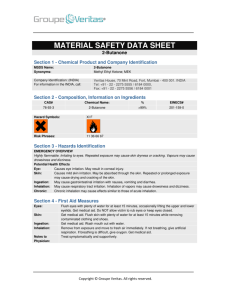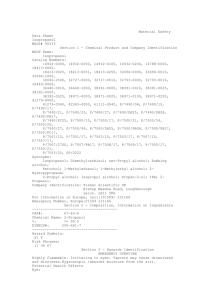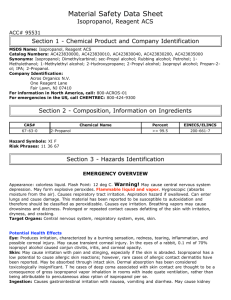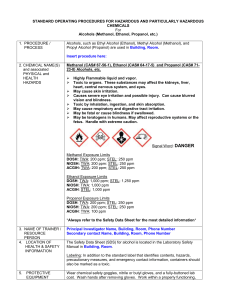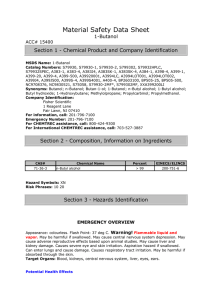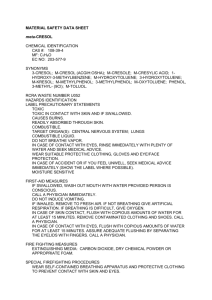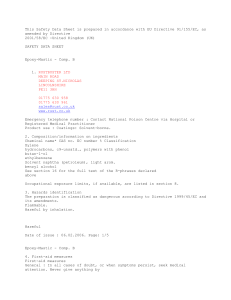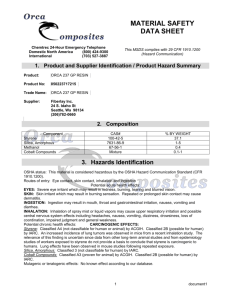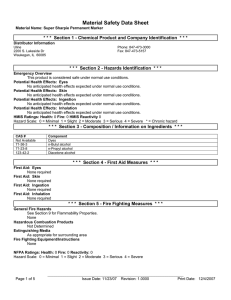**** MATERIAL SAFETY DATA SHEET **** Isopropanol, anhydrous
advertisement
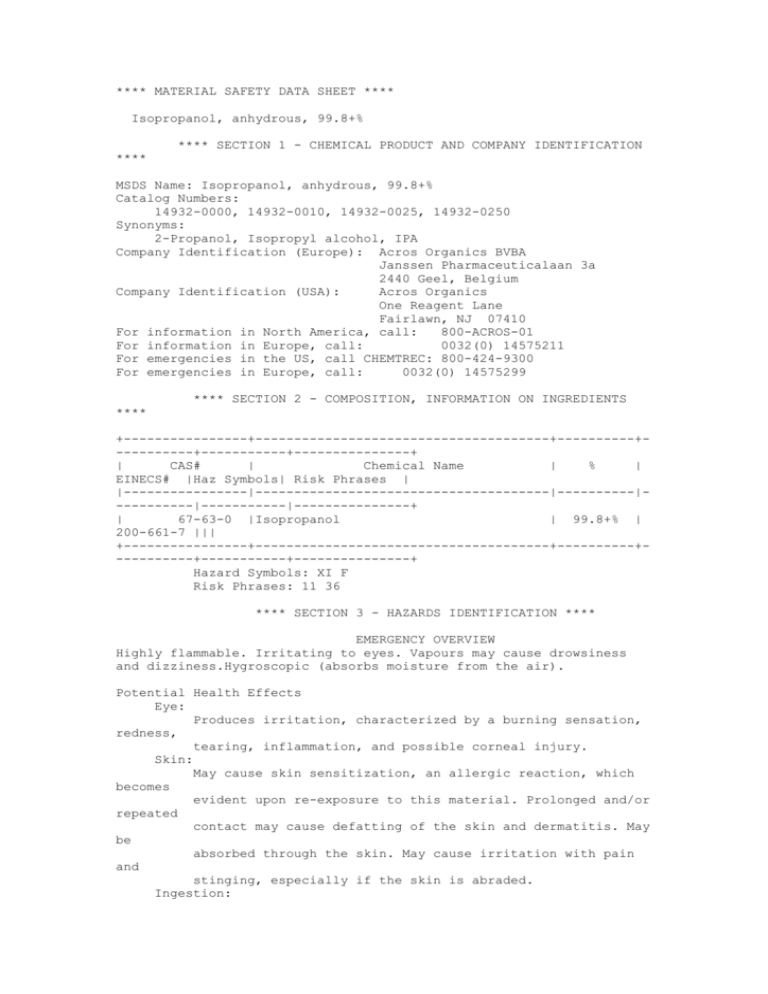
**** MATERIAL SAFETY DATA SHEET **** Isopropanol, anhydrous, 99.8+% **** SECTION 1 - CHEMICAL PRODUCT AND COMPANY IDENTIFICATION **** MSDS Name: Isopropanol, anhydrous, 99.8+% Catalog Numbers: 14932-0000, 14932-0010, 14932-0025, 14932-0250 Synonyms: 2-Propanol, Isopropyl alcohol, IPA Company Identification (Europe): Acros Organics BVBA Janssen Pharmaceuticalaan 3a 2440 Geel, Belgium Company Identification (USA): Acros Organics One Reagent Lane Fairlawn, NJ 07410 For information in North America, call: 800-ACROS-01 For information in Europe, call: 0032(0) 14575211 For emergencies in the US, call CHEMTREC: 800-424-9300 For emergencies in Europe, call: 0032(0) 14575299 **** SECTION 2 - COMPOSITION, INFORMATION ON INGREDIENTS **** +----------------+--------------------------------------+----------+----------+-----------+---------------+ | CAS# | Chemical Name | % | EINECS# |Haz Symbols| Risk Phrases | |----------------|--------------------------------------|----------|----------|-----------|---------------+ | 67-63-0 |Isopropanol | 99.8+% | 200-661-7 ||| +----------------+--------------------------------------+----------+----------+-----------+---------------+ Hazard Symbols: XI F Risk Phrases: 11 36 **** SECTION 3 - HAZARDS IDENTIFICATION **** EMERGENCY OVERVIEW Highly flammable. Irritating to eyes. Vapours may cause drowsiness and dizziness.Hygroscopic (absorbs moisture from the air). Potential Health Effects Eye: Produces irritation, characterized by a burning sensation, redness, tearing, inflammation, and possible corneal injury. Skin: May cause skin sensitization, an allergic reaction, which becomes evident upon re-exposure to this material. Prolonged and/or repeated contact may cause defatting of the skin and dermatitis. May be absorbed through the skin. May cause irritation with pain and stinging, especially if the skin is abraded. Ingestion: Causes gastrointestinal irritation with nausea, vomiting and diarrhea. May cause kidney damage. May cause central nervous system depression, characterized by excitement, followed by headache, dizziness, drowsiness, and nausea. Advanced stages may cause collapse, unconsciousness, coma and possible death due to respiratory failure. Inhalation: Inhalation of high concentrations may cause central nervous system effects characterized by nausea, headache, dizziness, unconsciousness and coma. May cause narcotic effects in high concentration. Vapors may cause dizziness or suffocation. Causes upper respiratory tract irritation. Chronic: Prolonged or repeated skin contact may cause defatting and dermatitis. **** SECTION 4 - FIRST AID MEASURES **** Eyes: Immediately flush eyes with plenty of water for at least 15 minutes, occasionally lifting the upper and lower eyelids. Get medical aid immediately. Skin: Get medical aid. Flush skin with plenty of water for at least 15 minutes while removing contaminated clothing and shoes. Ingestion: Do not induce vomiting. If victim is conscious and alert, give 2-4 cupfuls of milk or water. Never give anything by mouth to an unconscious person. Get medical aid immediately. Inhalation: Get medical aid immediately. Remove from exposure and move to fresh air immediately. If not breathing, give artificial respiration. If breathing is difficult, give oxygen. Notes to Physician: Urine acetone test may be helpful in diagnosis. Treat symptomatically and supportively. **** SECTION 5 - FIRE FIGHTING MEASURES **** General Information: As in any fire, wear a self-contained breathing apparatus in pressure-demand, MSHA/NIOSH (approved or equivalent), and full protective gear. Vapors may form an explosive mixture with air. Vapors can travel to a source of ignition and flash back. Will burn if involved in a fire. Containers may explode in the heat of a fire. Flammable liquid and vapor. May form explosive peroxides. Vapors may be heavier than air. They can spread along the ground and collect in low or confined areas. Extinguishing Media: Use water spray to cool fire-exposed containers. Use foam, dry chemical, or carbon dioxide. Use flooding quantities of water as spray. **** SECTION 6 - ACCIDENTAL RELEASE MEASURES **** General Information: Use proper personal protective equipment as indicated in Section 8. Spills/Leaks: Absorb spill with inert material (e.g. vermiculite, sand or earth), then place in suitable container. Remove all sources of ignition. Use a spark-proof tool. Provide ventilation. A vapor suppressing foam may be used to reduce vapors. **** SECTION 7 - HANDLING and STORAGE **** Handling: Wash thoroughly after handling. Ground and bond containers when transferring material. Use spark-proof tools and explosion proof equipment. Loosen closure cautiously before opening. Contents may develop pressure upon prolonged storage. Avoid breathing dust, vapor, mist, or gas. Avoid contact with skin and eyes. Empty containers retain product residue, (liquid and/or vapor), and can be dangerous. Take precautionary measures against static discharges. Do not ingest or inhale. Do not pressurize, cut, weld, braze, solder, drill, grind, or expose empty containers to heat, sparks or open flames. Storage: Keep away from heat, sparks, and flame. Keep away from sources of ignition. Store in a cool, dry place. Do not store in direct sunlight. Store in a tightly closed container. Flammablesarea. After opening, purge container with nitrogen before reclosing. Periodically test for peroxide formation on long-term storage. Addition of water or appropriate reducing materials will lessen peroxide formation. Store protected from moisture. **** SECTION 8 - EXPOSURE CONTROLS, PERSONAL PROTECTION **** Engineering Controls: Facilities storing or utilizing this material should be equipped with an eyewash facility and a safety shower. Use adequate general or local explosion-proof ventilation to keep airborne levels to acceptable levels. Personal Protective Equipment Eyes: Wear chemical goggles. Skin: Wear appropriate protective gloves to prevent skin exposure. Clothing: Wear appropriate protective clothing to prevent skin exposure. Respirators: Follow the OSHA respirator regulations found in 29 CFR 1910.134 or European Standard EN 149. Always use a NIOSH or European Standard EN 149 approved respirator when necessary. **** SECTION 9 - PHYSICAL AND CHEMICAL PROPERTIES **** Physical State: Color: Odor: pH: Vapor Pressure: Viscosity: Boiling Point: Freezing/Melting Point: Autoignition Temperature: Flash Point: Explosion Limits, lower: Explosion Limits, upper: Decomposition Temperature: Solubility in water: Specific Gravity/Density: Molecular Formula: Molecular Weight: Clear liquid APHA: 10 max alcohol-like - pleasant odor 7 (1% aq.sol.) 43 mm Hg @ 20 deg C 2.27 mPas 20 deg C 81 - 83 deg C @ 760 mmHg -89.5 deg C 425 deg C ( 797.00 deg F) 12 deg C ( 53.60 deg F) 2 vol % 12 vol % Miscible. .7850g/cm3 C3H8O 60.10 **** SECTION 10 - STABILITY AND REACTIVITY **** Chemical Stability: Stable at room temperature in closed containers under normal storage and handling conditions. Distillation may lead to the formation of peroxides. This material may be sensitive to peroxide formation. Conditions to Avoid: Incompatible materials, light, ignition sources, exposure to moist air or water. Incompatibilities with Other Materials: Oxidizing agents, acids, alkali metals, alkaline earth metals, aluminum, halogens, acid anhydrides, oleum. Hazardous Decomposition Products: Carbon monoxide, carbon dioxide, peroxides. Hazardous Polymerization: Will not occur. **** SECTION 11 - TOXICOLOGICAL INFORMATION **** RTECS#: CAS# 67-63-0: NT8050000 LD50/LC50: CAS# 67-63-0: Draize test, rabbit, eye: 100 mg Severe; Draize test, rabbit, eye: 10 mg Moderate; Draize test, rabbit, eye: 100 mg/24H Moderate; Draize test, rabbit, skin: 500 mg Mild; Inhalation, mouse: LC50 = 53000 mg/m3; Inhalation, rat: LC50 = 16000 ppm/8H; Inhalation, rat: LC50 = 72600 mg/m3; Oral, mouse: LD50 = 3600 mg/kg; Oral, mouse: LD50 = 3600 mg/kg; Oral, rabbit: LD50 = 6410 mg/kg; Oral, rat: LD50 = 5045 mg/kg; Oral, rat: LD50 = 5000 mg/kg; Skin, rabbit: LD50 = 12800 mg/kg. Not available. Carcinogenicity: Isopropanol Not listed by ACGIH, IARC, NIOSH, NTP, or OSHA. See actual entry in RTECS for complete information. **** SECTION 12 - ECOLOGICAL INFORMATION **** Ecotoxicity: Daphnia: LC50 = 4600 mg/l; 24 H;Fish: Fathead Minnow: 11.830 mg/l; 1 H; Static BioassayFish: Goldfish: LC50 = 5 g/l; 24 H; .Acute aquatic effects: Fathead minnow: LC50 =1000 mg/L/96 Hr. Golden orfe: LC50 = 8970 mg/L/48 Hr. goldfish: LC50 = GT5000 mg/L/24 Hr. Other Biodegradable. This chemical is not likely to bioconcentrate. **** SECTION 13 - DISPOSAL CONSIDERATIONS **** Dispose of in a manner consistent with federal, state, and local regulations. **** SECTION 14 - TRANSPORT INFORMATION **** IATA Shipping Name: Hazard Class: UN Number: Packing Group: ISOPROPANOL 3 1219 II Shipping Name: Hazard Class: UN Number: Packing Group: RID/ADR Shipping Name: Hazard Class: UN Number: Packing group: ISOPROPANOL 3 1219 II IMO ISOPROPANOL 3 1219 II **** SECTION 15 - REGULATORY INFORMATION **** European/International Regulations European Labeling in Accordance with EC Directives Hazard Symbols: XI F Risk Phrases: R 11 Highly flammable. R 36 Irritating to eyes. R 67 Vapours may cause drowsiness and dizziness. Safety Phrases: S 7 Keep container tightly closed. S 16 Keep away from sources of ignition - No smoking. S 24/25 Avoid contact with skin and eyes. S 26 In case of contact with eyes, rinse immediately with plenty of water and seek medical advice. WGK (Water Danger/Protection) CAS# 67-63-0: 1 United Kingdom Occupational Exposure Limits CAS# 67-63-0: OES-United Kingdom, TWA 400 ppm TWA; 999 mg/m3 TWA CAS# 67-63-0: OES-United Kingdom, STEL 500 ppm STEL; 1250 mg/m3 STEL United Kingdom Maximum Exposure Limits Canada CAS# 67-63-0 is listed on Canada's DSL List. CAS# 67-63-0 is listed on Canada's Ingredient Disclosure List. Exposure Limits CAS# 67-63-0: OEL-AUSTRALIA:TWA 400 ppm (980 mg/m3);STEL 500 ppm (1225 mg/m3) OEL-BELGIUM:TWA 400 ppm (985 mg/m3);STEL 500 ppm (1230 mg/m3) OEL-DENMARK:TWA 200 ppm (490 mg/m3);Skin OEL-FRANCE:STEL 400 ppm (980 mg/m3) OEL-GERMANY:TWA 400 ppm (980 mg/m3) OEL-JAPAN:STEL 400 ppm (980 mg/m3) OEL-THE NETHERLANDS:TWA 400 ppm (980 mg/m3);Skin OEL-THE PHILIPPINES:TWA 400 ppm (980 mg/m3) OEL-RUSSIA:STEL 400 ppm (10 mg/m3) OEL-SWEDEN:TWA 150 ppm (350 mg/m3);STEL 250 ppm (600 mg/m3) OEL-SWITZERLAND:TWA 400 ppm (980 mg/m3);STEL 800 ppm OEL-TURKEY:TWA 200 ppm (500 mg/m3) OEL-UNITED KINGDOM:TWA 400 ppm (980 mg/m3);STEL 500 ppm;Skin OEL IN BULGARIA, COLOMBIA, JORDAN, KOREA check ACGIH TLV OEL IN NEW ZEALAND, SINGAPORE, VIETNAM check ACGI TLV US FEDERAL TSCA CAS# 67-63-0 is listed on the TSCA inventory. **** SECTION 16 - ADDITIONAL INFORMATION **** MSDS Creation Date: 12/14/1999 Revision #1 Date: 6/30/2000 The information above is believed to be accurate and represents the best information currently available to us. However, we make no warranty of merchantability or any other warranty, express or implied, with respect to such information, and we assume no liability resulting from its use. Users should make their own investigations to determine the suitability of the information for their particular purposes. In no way shall the company be liable for any claims, losses, or damages of any third party or for lost profits or any special, indirect, incidental, consequential or exemplary damages, howsoever arising, even if the company has been advised of the possibility of such damages.
